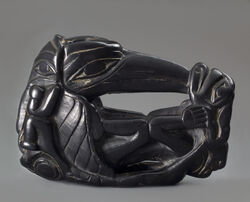The raven and the frog
September 2025

This title sounds like a fairy tale, perfectly matching the design of this pipe. It is carved from argillite, a coal-black stone related to slate, also referred to as claystone. The name is derived from the French word argil, which literally means clay. The pipe comes from the Haida, a people who live on Queen Charlotte's Island off the west coast of Canada in the Pacific Ocean. This amazing black stone is found there. Since the beginning of the nineteenth century, the Haida have been carving pipes with a very characteristic two-dimensionality. The two visible sides are dominated by fantastical, intertwined human and animal figures, depicted in a swirling representation in which the portrait heads look in all directions. Characteristic is the lack of naturalism, meaning that the proportions between the depicted figures can also be completely fantasy. In the pipe shown here, the raven is the main animal, a bird with high prestige in Haida culture. We also see a frog that is almost eaten and a human figure. It has not been handed down what exactly is meant by this figuration. Such imaginative works of art have been sold as souvenirs to travelers since about 1820. They are real collector's items, therefore, bought without the intention of being smoked. In any case, the art of the Haida is still loved and the panel pipes such as the one depicted here remain in demand worldwide.
Amsterdam Pipe Museum APM 30.426
Archive object of month